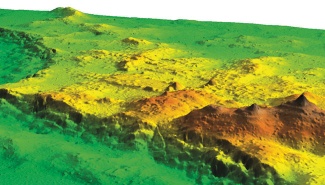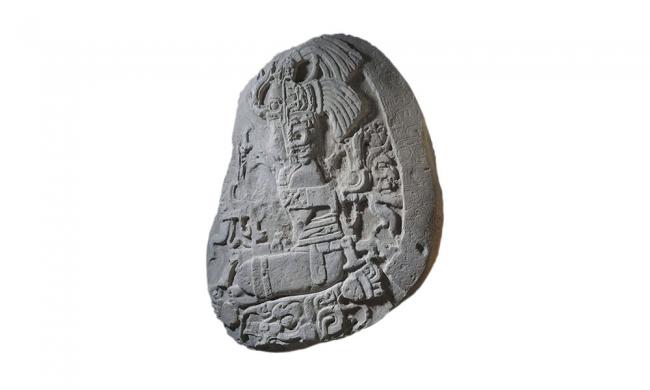From a 1,500-year-old carved altar to a stucco mask found inside a pyramid dating back to the 1st century B.C.E., they have uncovered dozens of artifacts, each with its own story about early life in the Maya lowlands.
Perhaps none are more impressive than their discovery of dozens of ancient cities in the Petén forest through the use of jungle-penetrating LiDAR (light detection and ranging) technology.
“This technology is revealing ancient settlement in the Petén forest of Guatemala at a scale never attained before, revolutionizing archaeologists’ view of ancient lowland Maya society,” said Canuto, director of the Middle American Research Institute (MARI) at Tulane.
The results of their work were published earlier this year in Science and include more than 61,000 ancient structures such as houses, palaces and pyramids; 362 square kilometers of terraces and 952 square kilometers of viable farmland; and 106 square kilometers of causeways within and between urban centers.
More Secrets of Maya History Revealed with Discovery of Altar
Northern Guatemala has proven to be fertile ground for archaeologists, and Tulane University researchers Marcello Canuto and Francisco Estrada-Belli have been among them, making some of the most eye-popping and remarkable discoveries the world has ever seen.
Northern Guatemala has proven to be fertile ground for archaeologists, and Tulane University researchers Marcello Canuto and Francisco Estrada-Belli have been among them, making some of the most eye-popping and remarkable discoveries the world has ever seen.

“Seen as a whole, terraces and irrigation channels, reservoirs, fortifications and causeways reveal an astonishing amount of land modification done by the Maya over their entire landscape on a scale previously unimaginable,” said Estrada-Belli, a research assistant professor and director of the Holmul Archaeological Project since 2000.
The PACUNAM LiDAR INITIATIVE (PLI) is the largest single LiDAR survey in the history of Mesoamerican archaeology. The collaborative scientific effort has provided fine-grained quantitative data of unprecedented scope to refine long-standing debates regarding the nature of ancient lowland Maya urbanism.
Since the collapse of the Classic Maya civilization in the A.D. 10th century, the region has been sparsely populated, dominated by a thick tropical forest that has blanketed most traces of the lowland Maya civilization that flourished in the region for over 1,500 years prior to the collapse.
“As a result, the region is an important focus of archaeological research despite its remoteness,” Canuto said. He has been researching the area since 2005 when he journeyed to the Classic Maya site of La Corona to determine whether it could be the subject of a long-term research project. He quickly found out that it could.
Among other activities, as co-director of the La Corona Regional Archaeological Project (PRALC), Canuto led a team of archaeologists in the discovery of a nearly 1,500-year-old carved altar. The discovery, announced Sept. 12, 2018, presents new evidence of how a powerful kingdom — known as Kaanul dynasty — began its two-century domination of much of the lowland Maya region.
“The discovery of this altar allows us to identify an entirely new king of La Corona who apparently had close political ties with the capital of the Kaanul kingdom, Dzibanche, and with the nearby city of El Peru-Waka,” said Canuto.
“Our research efforts have far-reaching impact beyond archaeology,” Canuto added. “In the end, we are trying to preserve the history of this part of the world.”
Marcello Canuto, director of Middle American Research Institute
The altar is made of limestone and displays the image of a previously unknown king, Chak Took Ich’aak, carrying a double-headed serpent effigy from which the site’s patron gods emerge. It is accompanied by a column of hieroglyphs that record the end of a half-katun period in the Long Count Maya calendar corresponding to May 12, 544 A.D.
A team led by Estrada-Belli excavated two tombs that contained a number of vessels and other objects made of materials precious to the Maya including a jade jewel inscribed with the name of a distant overlord. The finds add more evidence to the existence of the Kaanul dynasty ruling over the Classic Maya lowlands.
“There are still many cities like these still lying under the forest that hold many secrets about the Maya history, in spite of all the damage caused by centuries of natural erosion and looting,” Estrada-Belli said.
“Our research efforts have far-reaching impact beyond archaeology,” Canuto added. “In the end, we are trying to preserve the history of this part of the world.”
Main image: A carved limestone altar, 1,500 years old, is evidence of a powerful Maya kingdom known as the Kaanul dynasty. (Photo by Stuart David)































































